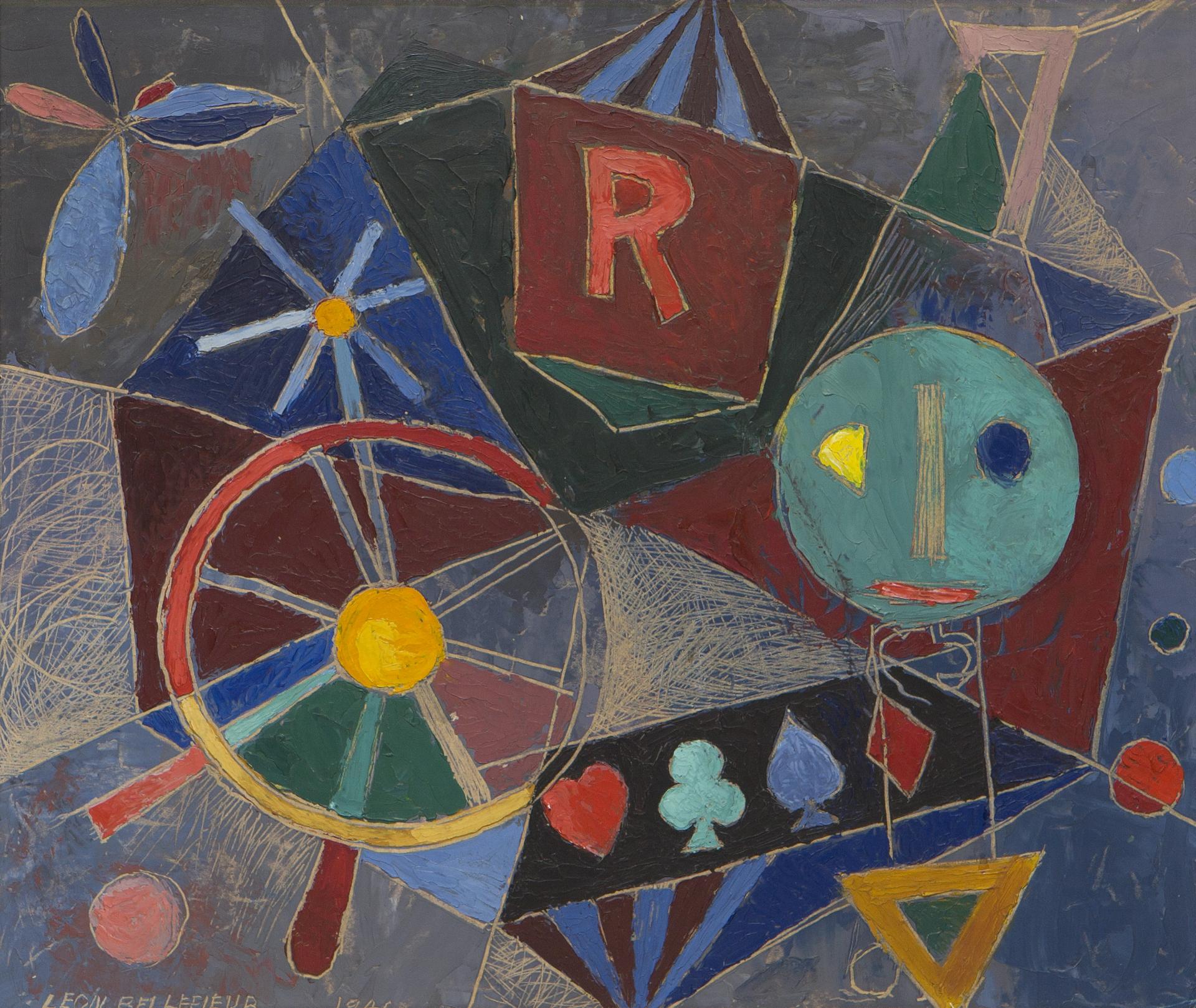
Untitled
31.5 cms x 37 cms (12.4 ins x 14.57 ins)
Signed and dated lower left
Lot offered for sale by BYDealers, Montréal at the auction event "Canadian Art Sale" held on Thu, May 31, 2018.
Lot 1
Lot 1
Estimate: CAD $20,000 - $25,000
Did not sell
Did not sell
Lot description - from the online catalogue*
Provenance:
Galerie Valentin, Montréal
Private collection, Montréal
Literature:
ROBERT, Guy. Bellefleur ou la ferveur à l'oeuvre, Montréal, Éditions Iconia, 1988, 239 p. OEuvre reproduite à la page 108 / Work reproduced on page 108.
Notes:
In March 1946, at the Maison des Compagnons in Outremont, Léon Bellefleur held his first exhibition, which also included artwork by his children. Bellefleur was fascinated by the surrealist worlds of Miró, Klee, and Breton, the abstractions of Kandinsky, and the onirism of Alfred Pellan, an artist whose company he keenly sought. In 1947, he wrote Plaidoyer pour l'Enfant (Plea for the Child), "which constituted his pedagogical and aesthetic manifesto as well as his moral and spiritual one," as explains Guy Robert (translation ours). The following year, he added his name to the Prisme d'yeux manifesto, written by Jacques de Tonnancour and signed by fourteen artists, in favour of a "living art" that stood against both academia and the radical ideology of the Automatistes. Working among young people, Bellefleur the instructor drew heavily, as Bellefleur the artist had, on the fresh energy that surrounded him: "True maturity, he wrote in Plaidoyer pour l'Enfant, is found in those who have preserved the gifts of childhood, developed them, and left behind all that is not in tune with his nature" (translation ours). Sans titre was painted during this inspiring period, full of decisive encounters, discoveries, and material play, such as the famous exquisite corpse that he carried out together with his friends Mimi Parent, Jean Benoit, Albert Dumouchel, and, later, Roland Giguère. This oil painting forms part of the same aesthetic lineage as Poisson dans la ville (1946), which is part of the National Gallery of Canada collection, and Hallucination (1946), also called Tentation, an important painting first purchased by François Hertel.1
Sans titre is decidedly among Bellefleur's more personal works, and was most likely presented in his first exhibition (the one that included his children's works). It features the same colourful, naïve style that characterizes the two works mentioned above, which are also dominated by outlines, scratchings, and paint that seems to have been applied with the fingers. Here, the amalgamation of primary forms resembles a game board animated by a roulette wheel, poker game suits, rolling roulette balls, and a lucky number seven. The prism, engraved with the letter R on one side, could be an affectionate nod to his wife, Rita Jolicoeur, with whom he had five children. Their youngest, Aube, born in 1946, is represented by the face with the small red lips.
(A.L.)
Galerie Valentin, Montréal
Private collection, Montréal
Literature:
ROBERT, Guy. Bellefleur ou la ferveur à l'oeuvre, Montréal, Éditions Iconia, 1988, 239 p. OEuvre reproduite à la page 108 / Work reproduced on page 108.
Notes:
In March 1946, at the Maison des Compagnons in Outremont, Léon Bellefleur held his first exhibition, which also included artwork by his children. Bellefleur was fascinated by the surrealist worlds of Miró, Klee, and Breton, the abstractions of Kandinsky, and the onirism of Alfred Pellan, an artist whose company he keenly sought. In 1947, he wrote Plaidoyer pour l'Enfant (Plea for the Child), "which constituted his pedagogical and aesthetic manifesto as well as his moral and spiritual one," as explains Guy Robert (translation ours). The following year, he added his name to the Prisme d'yeux manifesto, written by Jacques de Tonnancour and signed by fourteen artists, in favour of a "living art" that stood against both academia and the radical ideology of the Automatistes. Working among young people, Bellefleur the instructor drew heavily, as Bellefleur the artist had, on the fresh energy that surrounded him: "True maturity, he wrote in Plaidoyer pour l'Enfant, is found in those who have preserved the gifts of childhood, developed them, and left behind all that is not in tune with his nature" (translation ours). Sans titre was painted during this inspiring period, full of decisive encounters, discoveries, and material play, such as the famous exquisite corpse that he carried out together with his friends Mimi Parent, Jean Benoit, Albert Dumouchel, and, later, Roland Giguère. This oil painting forms part of the same aesthetic lineage as Poisson dans la ville (1946), which is part of the National Gallery of Canada collection, and Hallucination (1946), also called Tentation, an important painting first purchased by François Hertel.1
Sans titre is decidedly among Bellefleur's more personal works, and was most likely presented in his first exhibition (the one that included his children's works). It features the same colourful, naïve style that characterizes the two works mentioned above, which are also dominated by outlines, scratchings, and paint that seems to have been applied with the fingers. Here, the amalgamation of primary forms resembles a game board animated by a roulette wheel, poker game suits, rolling roulette balls, and a lucky number seven. The prism, engraved with the letter R on one side, could be an affectionate nod to his wife, Rita Jolicoeur, with whom he had five children. Their youngest, Aube, born in 1946, is represented by the face with the small red lips.
(A.L.)
Most realised prices include the Buyer's Premium of 18-25%, but not the HST/GST Tax.
(*) Text and/or Image might be subject matter of Copyright. Check with BYDealers auction house for permission to use.
(*) Text and/or Image might be subject matter of Copyright. Check with BYDealers auction house for permission to use.